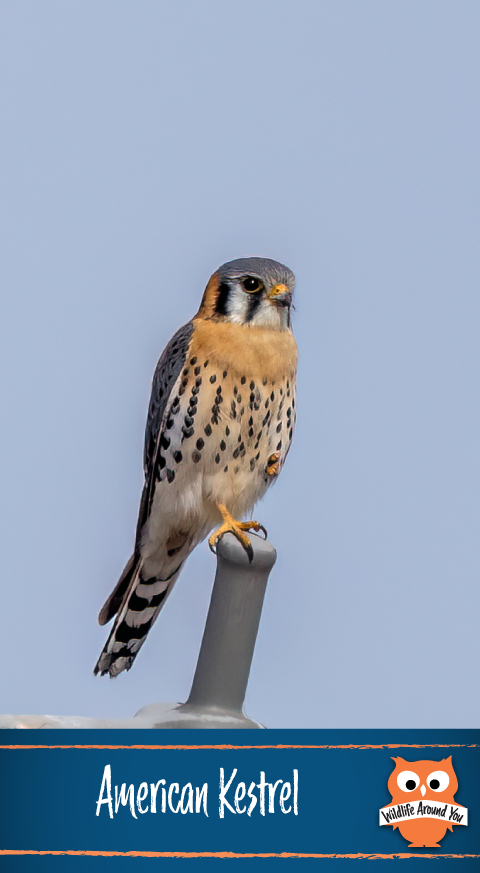Identification
It is the smallest falcon. When perched it’s roughly the size and shape of a mourning dove. (9-12 inches in length), (3-6 oz) but with a bigger head.
When flying they look pale from underneath and brownish red from above. The males have grey-blue wings while the females’ wings are reddish brown. Both sexes have black vertical markings on the face, sometimes called a “mustache” and a “sideburn”.
You might also see it hovering over a field with rapidly beating wings waiting to pounce on prey. This is sometimes called Kiting.
It’s the most common and widespread falcon in North and South America. Pretty much everywhere that isn’t too cold or covered in dense trees.
Habitat
Most likely to see them perching on powerlines or telephone wires along roadways where there is open country and short vegetation. From deserts and grasslands to alpine meadows. They just need open spaces with few trees.
Nesting
They nest in preexisting cavities like old woodpecker holes, natural tree hollows, rock crevices, and nooks in buildings and other human-built structures. The male searches for possible nest cavities. When he’s found suitable options, he shows them to the female, who makes the final choice.
Typically, nest sites are in trees along wood edges or in the middle of open ground. American Kestrels take readily to nest boxes.
They do not use nesting materials. If there is loose material on the floor the female will hollow out a small depression there.
Behavior
They are graceful flyers, but light enough that the wind can blow them around. When perched they will often pump their tail or move their body as if they are trying to balance.
They are solitary birds except during pair-bonding and mating season.
During the breeding season, males promote their territory by repeatedly climbing and then diving, uttering a short series of calls at the top of each ascent. At the beginning of the pairing-up process, groups of four or five birds may congregate. Kestrels will also harass larger hawks and eagles during migration, and attack hawks in their territories during the breeding season.
Offspring
They have 1-2 broods with a clutch size of 4-5 eggs. The eggs are incubated for about a month, and then the birds are nestlings for about a month.
Predators
Larger raptors like hawks and owls.
Diet
Mostly eat insects and other invertebrates along with some small birds and rodents. Food like: grasshoppers, cicadas, beetles, and dragonflies; scorpions and spiders; butterflies and moths; voles, mice, shrews, bats, and small songbirds. Sometimes they might eat small snakes, lizards, and frogs.
Normally hunt during the day, by pouncing on prey. The birds may eat on the ground or carry it back to a perch.
Fun Facts
Studies have shown that American Kestrels can see ultraviolet light. It’s speculated that this lets them see the urine trials of small mammals that might become a snack.
There are several theories about these spots and markings on the head mostly centering on them having the appearance of eyes. This may detour attackers as it can appear that the kestrel is always watching them.
Kestrels cache or hide uneaten kills to save for when prey may be scarce.
Growing nestlings eat twice as much food in a day as an adult. That amounts to 2 or 3 mice or voles a day.
Vole populations directly affect the kestrel breeding season. If there are lots of voles in the territory, there will be lots of fledglings.
Kestrel numbers are declining, but scientists are having a hard time figuring out why. They may one day be on the endangered list. In the wild, they only live for about 5 years.
They have some nicknames- Sparrow-hawk (not to be confused with the Eurasian sparrow hawks), grasshopper hawk, and killy hawk (related to the calls they make).
They are a common bird used in Falconry, especially for beginners.

